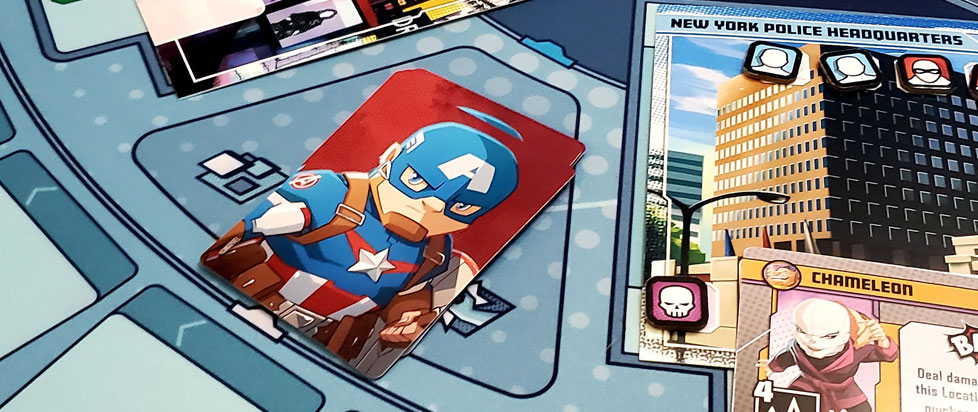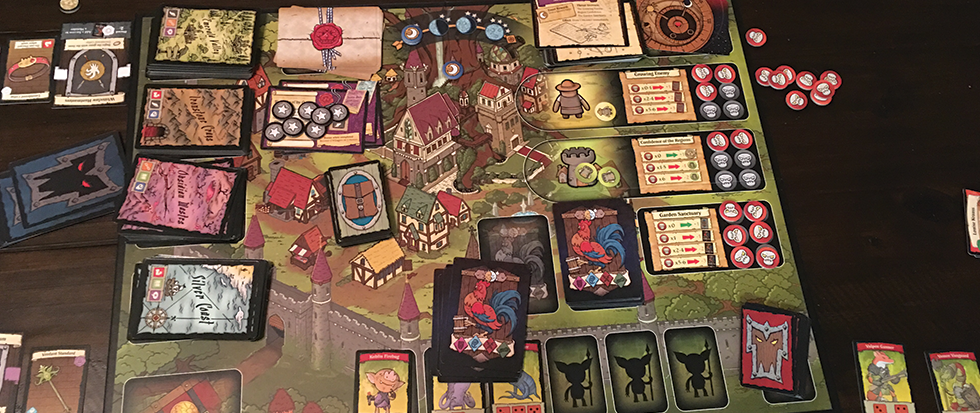
Heroic Action: Defeating Evil with a Little Help from Your Friends in Marvel United
I see board games in the store and they always look so cool and then I buy them and bring them home, I’m so excited to open them, and then I play them, like, twice… This column is dedicated to the love of games for those of us whose eyes may be bigger than our stomachs when it comes to playing, and the joy that we can all take from games, even if we don’t play them very often.
It may not be saying much these days – when the vast majority of the most profitable movies in the world are part of the Marvel Cinematic Universe and you can buy Marvel-themed every damn thing from just about any big box store on the planet – but I grew up a Marvel comics nerd. I inherited a few issues from my older brothers and later bought my own, but what I really got into were character trading cards, which were cheaper than reading the comics, after all.
Which is all a long way of saying that, while I’ve now been out of the comic book superhero scene for far longer than I was ever in it, I still have a certain fondness (and a remarkable amount of useless trivia knowledge) regarding the Marvel characters that I grew up with. Fast forward to March of 2020, when CMON (we’ve talked about them a lot in this here column) launched a Kickstarter for a new game called Marvel United.
Actually, fast forward to April of 2021, because I missed that initial Kickstarter, even though March of 2020 would have been right around the time I was getting deep back into these weeds. The 2021 Kickstarter that caught me was actually for a standalone expansion featuring X-Men characters – intended to be fully compatible with the previous release, so that the two could mix and match components.
I backed that one – the core box arrived in October, with Kickstarter exclusives still to come – but, my curiosity piqued, I also picked up the original core game and some of its expansions. What initially made me look twice was the Marvel branding, I’ll admit, but what made me actually throw in my hat was the game’s central conceit.
The idea here is that each player takes control of a superhero and you’re all playing against the board in the form of a super villain. The original core box has three villains and seven heroes, all of whom will be familiar to fans of the MCU, while Kickstarter exclusives and other expansions add many more of both. Each hero brings a certain modest amount of variation to play style, but it’s really the choice of villain that changes how the game unfolds.
Each villain has their own unique win and lose conditions, and each one brings different mechanics to the table, obliging the heroes to combine their efforts in different ways in order to come out on top. None of that is particularly novel, however. The real magic of this game comes from how you combine those efforts.
Aside from sturdy little chibi miniatures, the heroes are represented by a small deck of cards. These cards usually have one or more symbol on them, representing either attacks, “heroic actions,” or movement. When you play a card, you can use those symbols for relevant actions in your turn.
Here’s where Marvel United’s rather brilliant conceit takes over, though. You don’t just have access to the symbols on the card you play. You can also use the symbols on the card that the last player put down on their turn. Meaning that each player sets up the actions of the next, in addition to their own, creating a kind of chain of teamwork that is incredibly simple but surprisingly robust in execution.
In fact, one of my only complaints about the game is that the “storyline” (what the game calls the string of cards as they’re played) can quickly become a little confusing if you’re playing the game right out of the box. The Kickstarter included an option for a neoprene playmat that simplifies the laying out of the cards considerably, and might be the first playmat I’ve ever encountered that is all-but indispensable.
Like just about any fully co-op game, Marvel United can also be played solo, with one player simply taking control of three heroes. (The X-Men version, which clarifies several of the rules that were slightly confusing in the original, also adds another alternative way to play the game, in which one player takes control of the villain instead of letting them be controlled by the board.) Playing solo is pretty fun, still, but it loses something. That feeling of camaraderie that comes with a accomplishing a task together that you couldn’t have done alone.
And it is that feeling of teamwork that really makes Marvel United special. It’s a fun enough game, quick to learn and easy to play, and there’s a lot of variety generated by the different villain options. Hilariously, when I picked it up at a friendly local game store, a rando customer felt the need to inform me that he had thought about picking that one up but it just didn’t seem like there was any “replay value.” (I refrained from telling him that I was sure that the store really appreciated him telling me that as I was literally headed to the counter to buy the game.) But what has convinced me to play Marvel United more than, like, twice is that co-op spirit. Few other games have harnessed the sense of working together and relying one-another quite so elegantly.
And that’s what the holidays are all about, right?





